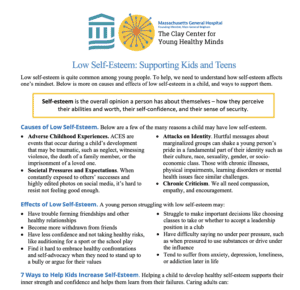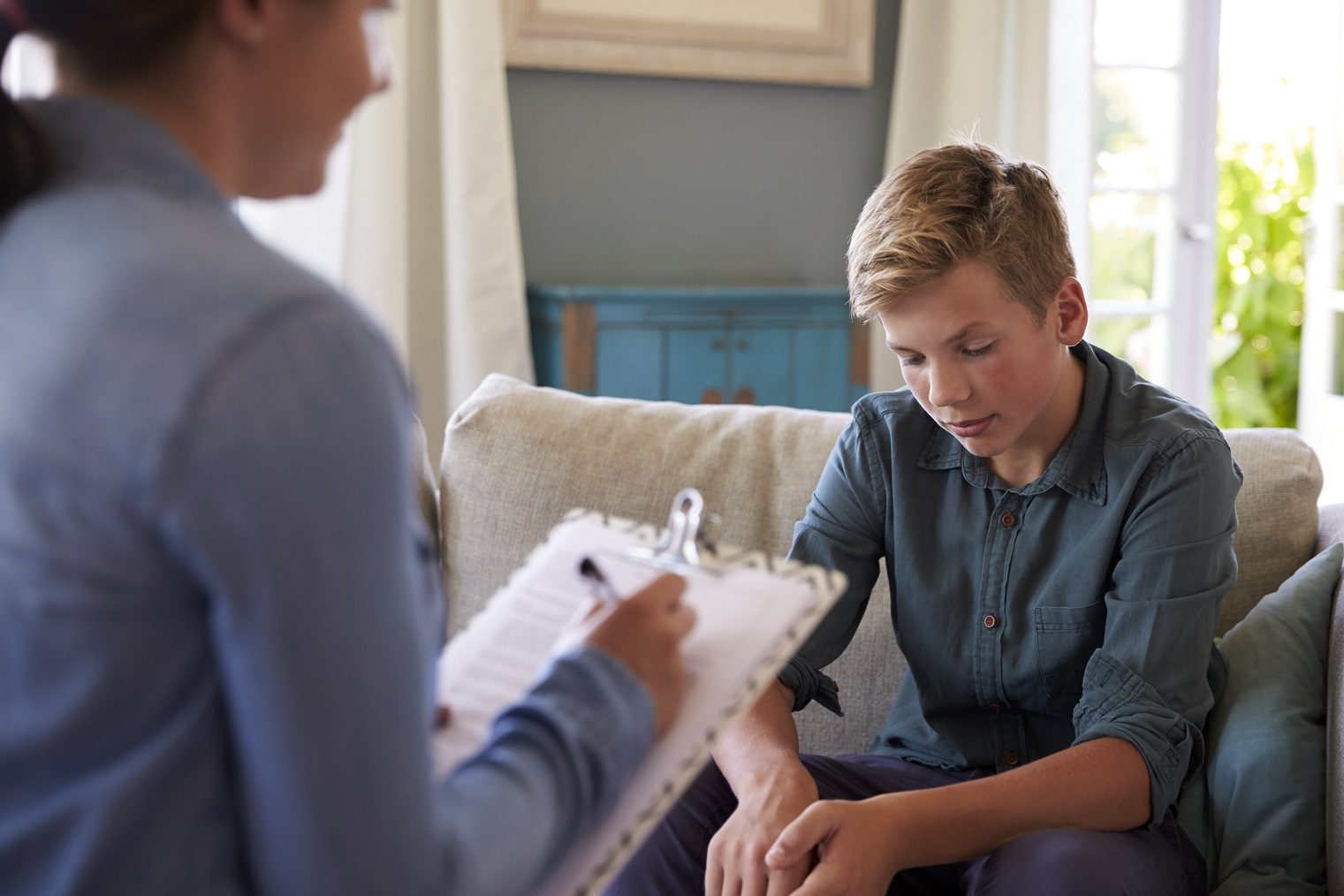Low Self-Esteem: Where Does It Come From and What Can Adults Do to Help?

Posted in: Grade School, Parenting Concerns, Teenagers
Topics: ADHD, Child + Adolescent Development
You can also listen to more about self-esteem below, or ‘Shrinking It Down’ wherever you get your podcasts.
Let’s consider two adolescent scenarios. First, Sasha:
Sasha was born a worrier. She’s always been a shy, sensitive kid with a lot of anxiety. Luckily, she’s had supportive family members, friends, and teachers, who have gently pushed her out of her comfort zone.
But a few years ago, Sasha’s home-life took a turn for the worse. Her parents started arguing regularly, behind closed doors at first, but soon enough in front of their children. In this stressful environment, Sasha’s natural sensitivity and anxiety caused her to believe she was somehow to blame for all the arguing.
Now 12 years old, Sasha has been exposed to this family conflict for so long that it’s damaged her self-esteem. She started middle school, where she’s met many new kids, but she has had trouble forming friendships without constantly wondering how others perceive and value her, and most importantly, what she can do to maintain their friendship.
Sasha constantly worries she has done or said something that will make her friends dislike her. Yet, Sasha is incredibly likeable! She’s a very funny, empathetic person. Still, she is terrified of connecting with other kids because she thinks they could never possibly want to be her friend.
Now let’s look at Tyler:
At 15 years old, Tyler is a great student and avid soccer player. He also has ADHD. Tyler has always done well academically, as his ADHD presents mainly as impulsivity – not inattentiveness. But socially, Tyler sometimes has trouble stopping himself from interrupting others or withholding comments that can come across as insensitive or thoughtless.
Concerned that this behavior might be impacting his relationships, Tyler’s mom recently asked him if his impulsivity had caused any issues with friends. At first, Tyler denied it was a problem. But in truth, there was a pattern. His blurted-out comments have often resulted in hurt feelings, and even arguments. This has been going on for years, leading to a falling out between Tyler and some of his closest friends. Over time, his friends have become less tolerant, criticized him more openly, and stopped inviting him to hang out.
Tyler finally shares with his mom that he’s overwhelmed by the damage to his friendships. The conflict has left him feeling guilty, ashamed, and often rejected by some of his favorite people. His mom notices he has been asking for less playtime in his soccer games, and teachers report Tyler is much quieter in class. He rarely asks his friends to hang out anymore, even though Tyler has always been a passionate student-athlete and a social butterfly.
Self-esteem is at the core of both Sasha’s and Tyler’s stories, and to help them, we need to understand how self-esteem affects our mindset. Self-esteem is the overall opinion a person has about themselves – how they perceive their abilities and worth, their self-confidence, and their sense of security.
People experience low self-esteem differently. For example, not everyone with low self-esteem is excessively self-critical, but no matter how it manifests, low self-esteem is quite common. Even the most successful people, including celebrities and athletes, often struggle with “pockets” of self-doubt in certain parts of their lives.
Causes of Low Self-Esteem
Sasha’s and Tyler’s stories were written to depict common experiences for people growing up identifying with their respective genders. But no case study can completely reflect the complexity of any one group— anxiety, ADHD, and many other factors can cause low self-esteem, regardless of a person’s gender identity.
We’ll check in with Tyler and Sasha later, but for now, let’s step away from these two cases to consider all the reasons a child or teen might have low self-esteem:
- Chronic Abuse and Criticism: We all need compassion, empathy, and encouragement.
- Adverse Childhood Experiences (“ACEs”): ACEs are events that occur during a child’s development that may be traumatic, such as neglect, witnessing violence, the death of a family member, or the imprisonment of a loved one.
- Unresolved Guilt: When a child has a conflict with a loved one, they might feel anger and hate laced with their love for that person. These conflicting feelings cause an anxiety state we call guilt. The child resolves this state by making amends with the loved one. But, when that person is unavailable, abandons the child, or refuses to “kiss-and-make-up,” the child cannot resolve the guilty feelings. Guilt becomes internalized, leading to low self-esteem.
- Societal Pressures and Expectations: We are all constantly exposed to the successes of friends and family on social media, accomplished celebrities, and highly-edited photos of people in the media and advertisements. It’s hard to resist comparison and the feeling of not being good enough. Society’s unreasonable and unattainable expectations are damaging to self-worth.
- Attacks on Identity: Hurtful messages about marginalized people can shake a young person’s pride in a fundamental part of their identity such as their culture, race, sexuality, gender, or socio-economic class. Those with chronic medical illnesses, physical impairments, learning disorders or mental health conditions face similar challenges.
Effects of Low Self-Esteem
We saw how Sasha’s low self-esteem impaired her ability to form healthy relationships, and how Tyler became much more withdrawn as a result of his low self-esteem. How else might it affect a young person? Young people with low self-esteem may:
- Demonstrate less confidence and avoid taking healthy risks, such as auditioning for a school play
- Struggle making important decisions, such as choosing which classes to take or whether to accept a leadership position in a club
- Have difficulty saying no under peer pressure, such as when pressured to use substances or drive under the influence
- Find it hard to embrace healthy confrontations and self-advocacy when they need to stand up to a bully or argue for their values
- Tend to suffer from anxiety, depression, loneliness, or addiction later in life
How to Help Young People Increase Self-Esteem
One of the greatest gifts we can pass along to children is the belief that they have inherent value and are worthy of being loved for who they are.
By helping a young person develop healthy self-esteem, we support their inner strength and confidence, and help them learn from their failures. The younger we start helping the better, but it’s never too late to begin improving a young person’s self-esteem. Caring adults can:
- Show children unconditional love, encouragement, and praise. Even when kids fail or misbehave, we can show compassion as we process the situation together.
- Help children have a positive impact in another person’s life. This can be done through volunteering in the school or community, helping younger siblings, or assisting parents with chores.
- Help young people improve their favorite skills and activities. Confidence and competence go hand-in-hand, and when kids feel proud of their abilities, they’ll also feel more positive about themselves.
- Help young people develop a realistic and positive view of themselves by reflecting accurately on their strengths and weaknesses. Be sure to do this in a non-judgmental way. No matter the age, we grow the most when we see failures as an opportunity to learn about ourselves.
- Give young people the chance to take responsibility for their actions. This includes the chance to apologize when they experience conflict.
- Identify and challenge negative thought patterns, which are often exaggerated and distorted, and erode self-esteem.
- Help young people take pride in their unique identity and their differences. These include sexuality, gender, race, ethnicity, and family constellations.
- Model positive behaviors. Demonstrate to your child how you practice self-compassion, and don’t hide your setbacks from your child.
The Final Word
The good news is that there are many ways to help our young people improve self-esteem. Let’s see how things turned out for Sasha and Tyler.
For Sasha, it took three steps and a bit of time:
- Knowing his daughter well, Sasha’s dad noticed her withdrawn behavior and began having gentle conversations about what was troubling her. Sasha opened up, admitting she felt guilty about causing problems in the family. She was repeatedly reassured that the conflicts were not her fault.
- Sasha’s parents asked her primary care pediatrician to help schedule a clinical evaluation. The evaluation revealed that Sasha has generalized anxiety disorder and a shy, inhibited temperament.
- At the evaluator’s recommendation, Sasha began individual and family therapy. Her parents also started couple’s therapy. The family considered medications for Sasha’s generalized anxiety but decided they were not needed at the moment.
Over the course of a few months, Sasha’s self-esteem grew greatly. She engaged with friends with less anxiety, and most importantly, she experienced less guilt surrounding her home life.
In Tyler’s case, his mom realized something needed to be done. They had a few joint meetings with his psychopharmacologist and came up with the following plan:
- Tyler’s stimulant medication was adjusted, and the dosage was increased. The psychopharmacologist also prescribed a second medication, Tenex (guanfacine), which helps to reduce impulsivity without affecting attentiveness.
- Cognitive Behavior Therapy (CBT) was initiated to work on modifying Tyler’s thoughts and practice thinking before acting. He became less short-fused and more mindful of the consequences of his behavior.
- Since his impulsivity had also been noticeable at home, Tyler’s mom held family meetings, which included his brother, to help him learn behavioral strategies and skills.
- Tyler’s mom initiated a CORE evaluation to review his special accommodations in school. This resulted in changing his seat in school, scheduling meetings with the school guidance counselor, and getting constructive feedback from school staff regarding his impulsive behavior.
After 6 months of this plan, Tyler’s interpersonal behavior improved significantly, along with greater self-esteem, pride, and self-confidence.
Tyler and Sasha are fictional, but the problems they experienced are as real as they are common. When a young person experiences low self-esteem, the adults in their life have an opportunity to help them develop confidence and resilience that will carry them far in life. We can find hope in remembering that the solutions to low self-esteem are even more diverse than are the causes. Knowledge, conversations, and love will lead the way to a world of change.



 Share
Share Tweet
Tweet






